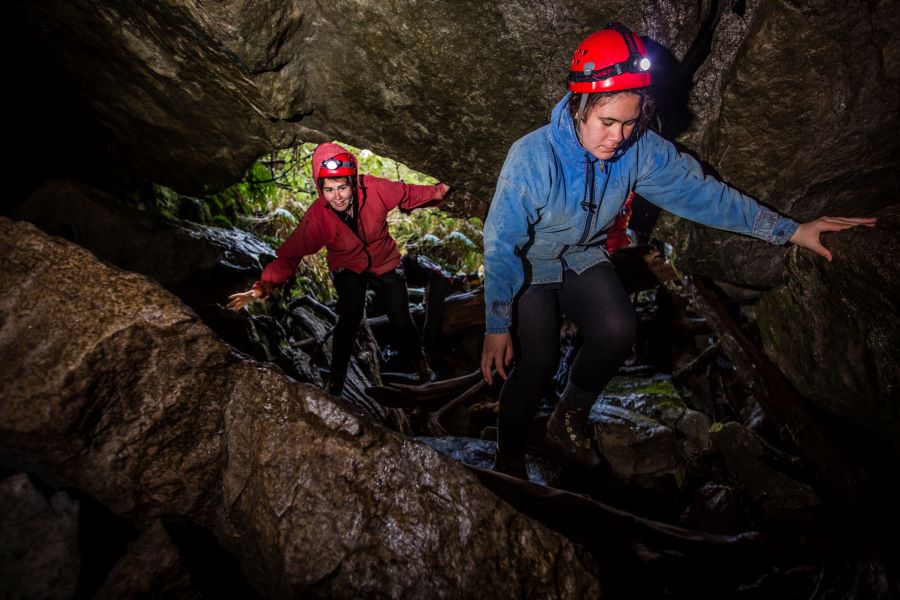Cave
Cave Leader
The holder of this qualification can lead trips of up to 3 hours duration in horizontal caves where a maximum drop height of 3m is not exceeded. The cave must have easy access in and out for group management and in case of an emergency. The trips will be on well established routes. A low flow streamway may be encountered that does not require swimming or deep water management.
The cave leader can rig, instruct and manage simple handlines to assist clients on short vertical steps.
Two day assessment.
Cave 1
The holder of this qualification can organise, instruct and guide clients in horizontal caves where short vertical single pitches are expected and active streamways may be encountered. Short vertical pitches up to 15 metres, include only those where there is a clear line of sight and voice communication between the top and bottom person at all times.
The Cave 1 instructor can rig, manage and instruct the use of ladders, abseiling and belaying techniques to negotiate vertical pitches. Deep and moving water management techniques can be used to negotiate the active streamways.
Two-day assessment.
Single Rope Technique Endorsement
The holder of this qualification can organise and instruct and guide single pitch cave SRT trips where rope and anchors are not the primary means of support between pitches.
One-day assessment.
Single Rope Technique Endorsement Scope and Syllabus
Single Rope Technique Endorsement Assessment - Course Outline



Photo Credits: Neil Silverwood
Course Outlines | Whakamāramatanga o te akoranga
On a NZOIA assessment there are a wide range of skills and knowledge that you will be tested on. Your Assessor will endeavour to ensure all areas in the syllabus are assessed. Below are outlines of what will likely be covered (depending on environmental conditions and other considerations at the time of the assessment) and how it relates to the syllabus.
Cave Leader Assessment
Pre-course Information
Read and be familiar with the:
Leader Workbooks
- Cave Leader Workbook
- Core Knowledge Workbook (You only need to complete this once. If you already hold a Registered NZOIA Leader, 1 or 2 qualification you do not need to complete this workbook).
It is optional for NZOIA Assessment Centre tertiary students to complete the workbooks as the content may be assessed as part of the tertiary course curriculum. Please follow the requirements of your tutor/Assessor.
Applicable components from the NZOIA Cave Leader Syllabus:
- Section 1: Describe the structure of caving organisations in New Zealand
- Section 2: Demonstrate and/or describe the care and correct use of cave equipment and clothing
- Section 6: Obtain a weather forecast and apply weather interpretation skills
- Section 7: Demonstrate cultural and environmental knowledge and interpretation of areas visited
- Section 8: Role model and promote accepted environmental practices
- Section 10: Demonstrate effective safety management skills
Organise Equipment
Liaise with other candidates to organise equipment required for the course.
Cave 1 Assessment
Pre-course Information
Read and be familiar with the:
Presentation
Prepare an interactive, engaging and informative presentation to be delivered to fellow candidates on your allocated topic. It should be between 5-10 minutes in duration and delivered without the use of technology (unless you provide your own).
Assigned topic examples:
- Flora and Flora of caves in New Zealand
- Care, maintenance and longevity of caving gear and equipment
- Environmental impacts of caving and how to minimise them
- Cultural considerations when caving and how you could incorporate te ao Māori into a caving experience
- How caves are formed and geology of the assessment area
- The role of the NZ Speleological Society in caving
- The who and what of the NZ Cave Search and Rescue
- How did speleology in NZ develop as a sport?
Applicable components from the NZOIA Cave 1 Syllabus:
- Section 1: Describe understanding of the history and ethics of caving
-
Section 2: Demonstrate the care and correct use of cave equipment and clothing
-
Section 10: Role model and promote accepted environmental practices
- Section 11: Demonstrate and/or describe cultural and environmental knowledge and interpretation of caving sites visited
- Section 12: Understand connections between te ao Māori and the cave environment
Organise Equipment
Liaise with other candidates to organise equipment required for the course.
Single Rope Technique Endorsement
Pre-course Information
Read and be familiar with the:
- Single Rope Technique Endorsement Scope & Syllabus
- Assessments – What to expect
- Assessments – Feedback & Results Process
Organise Equipment
Liaise with other candidates to organise equipment required for the course.
Cave 2 Assessment
Pre-course Information
Read and be familiar with the:
The NZOIA 2 candidate is expected to demonstrate any of the competencies outlined in the NZOIA 1 Syllabus.
Presentations
There will be presentation components during the assessment. At some stage during the assessment, candidates will be required to give an impromptu talk on some aspects of the syllabus e.g. conservation practices and techniques for cavers, development of speleology as a sport, role of NZSS, NZSS ethical code for cavers, NZ Cave SAR, modern cave surveying techniques, clothing and equipment, geology and hydrology of a cave system, environmental and cultural considerations of cave rigging etc.
Applicable components from the NZOIA Cave 2 Syllabus:
- Section 1: Demonstrate an in-depth general knowledge relevant to caving
- Section 2: Demonstrate the care and correct use of cave equipment and clothing
- Section 8: Role model and promote accepted environmental practices
- Section 9: Demonstrate historical and environmental knowledge and interpretation
- Section 12: Prepare and deliver teaching sessions
Organise Equipment
Liaise with other candidates to organise equipment required for the course.
